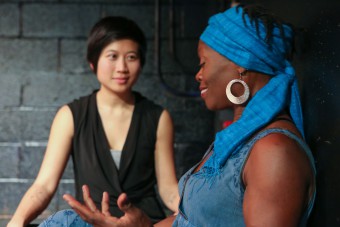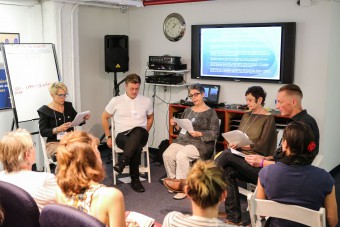
“It was like I had found my people. The over-sharers, the therapists who use the transformative power of art to change people, the movers, the dancers, the ones who skate towards rather than away from the hard topics, the taboo states of mind, who hunger for deep connections, the misfits, the ones who feel like they don’t belong, like they’re never enough, like they never do enough, the sensitive ones, the multilingual, the multicultural who live with intertwining cultures coursing through our veins… yes, yes, yes!”
The experience that prompted me to write this in my journal was the weekend I spent at Performing the World 2016 (PTW2016). I used the 16-hour flight from LAX to Melbourne to expand on these feelings here.
The official description for PTW 2016 is that it is “an international conference bringing together scholars and researchers, teachers, therapists, social workers and community organizers, doctors and other health workers, theatre and other performance artists, and economists from across the globe for a series of workshops, symposia and performances that showcase innovative practice and scholarship.” This year’s theme was: “Can we perform our way to power?”
Rani P Collaborations at PTW 2016
I had been invited to PTW2016 to speak about my performance making practice as Rani P Collaborations. I create intimate performance installations for small numbers of people at a time, which gently encourages our audiences to engage with topics that are often very difficult to sit and reflect on, including: racism, mass violence and child sexual abuse.
My vision through my work is to inspire conversations, self-reflection and social change through the performing arts. Some of the guiding principles of my practice are very much inspired by my earlier experiences as a Social Worker.
As a result, I was drawn to sessions at PTW2016 that bridged this curiosity between social work and the performing arts.

Performing a performance of a performance
One session was by Canadian academic, Jared French, entitled, “Performing a Performance of a Performance”. French has done his PhD, he joked, “on a metaphor”: the different ‘spaces’ that people often spoke about when engaging in therapy, in particular, family therapy. For example, therapists often spoke about creating ‘safe spaces’ through their work. French asked the question: “What made these spaces identifiable?”
Eventually, he came to suggest that there are three types of spaces that are created in therapy:
- A space for Reflection
- A space for Generativity: Bringing into existence new perspectives and transcendence: going above past possibilities
- A space of Commitment: Of the family pledging together and agreeing to deliberate action in the future that would be beneficial in some way
Through his presentation, French shared a transcript of a particular family therapy session. Four audience members, including myself, volunteered to ‘perform’ the script.
French’s analysis then highlighted how the factors that created these three spaces included: the therapist’s ability to match a family’s pace and rhythm, the use of humour, persistence, an ability to comfort one another and the therapist continuously ‘checking in’: “Is this what you mean by…?”
Importantly, French pointed out how these spaces are created together, involving a ‘co-editing’ and negotiation between all parties. As a result, “Particular conversations which have not been possible are made possible.”
I found French’s findings extremely relevant to my own work as a socially engaged performance maker.
For example, my most recent work, Sedih // Sunno, encouraged our audiences to sit and reflect on my mother’s experiences of having been sexually abused as a child. As a performance maker, I was very aware of the need to create a ‘space’ in which people may feel safe enough to pause, sit and engage with this topic. As the main verbal storyteller, it was part of my job to match each group of audience members’ pace and rhythm, to use humour to put them at ease and then to create a structured experience within which the audience could feel ‘held’ during their emotional journey through the work.
For Sedih // Sunno, I worked with an interdisciplinary team of artists: including vocalist/ composer Ria Soemardjo, a visual artist Shivanjani Lal and an arts therapist Kei Murakami. In addition to the ‘space’ that was created through my verbal storytelling, we gave audiences a clear structured experience through the use of visual and lighting cues, smells, calming and meditative music as well as simple repeated, centering rituals involving the ringing of bells.
French’s presentation had many parallels with the acts of negotiation that I engage with as a performance maker, on a moment-by-moment basis with each new group of audience members, within the ritualistic boundaries of a performance. I ask myself: “What is my duty-of-care towards my audience, who have consented to experience my work?”
Curtains Up! Anxiety Down!
Another highlight of PTW2016 for me was Lesly Fredman and Murray Dabby’s workshop on social anxiety which was attended by more than 50 people.
Fredman and Dabby began with a sharing of key statistics on the ‘epidemic of social anxiety’ in the United States. Fredman and Dabby pointed to the consequences of living in a ‘success’ driven culture: shame, self-loathing, self-judgment but also, social isolation. In 1984, 10% of people in the USA reported not having a confidante/ close friend. Twenty years later, in 2004, they quoted that 25% of people reported not having a confidante.
In response, Fredman and Dabby have devised a 12-week program to encourage people to work through their at times debilitating experiences of anxiety.
I had been drawn to this workshop because of my own struggles with anxiety, which peaked in 2015. The irony, of course, was that I felt anxious going to a workshop on Social Anxiety.
One valuable exercise was in the form of personifying the ‘Saboteur’ in your head. The Saboteur is that inner voice, which sabotages your confidence and belief in yourself. Fredman and Dabby encouraged us to give this ‘Saboteur’ a name. In my case, her name was, ‘Ridiculous Rani’. ‘Ridiculous Rani’ would pipe up loudly at the possibility of a new intimate relationship in my life and convince Rani that she was “too fucked up for anyone to ever want to be with”. I was surprised by how many people nodded and chuckled to indicate that they could relate to this particular Saboteur’s ‘expertise’.
We were then encouraged to talk about a recent example of when our Saboteur had been ‘successful’ in sabotaging us. And these stories (some of them tragically funny) were then applauded as ‘success’ stories.
Some people shared how personifying and externalizing their saboteurs in this way made them more “able to be tackled” and many shared how they were able to relate to multiple people’s Saboteurs.
Fredman and Dabby then explained how following the Saboteurs exercise, they would ask their clients to personify the Allies in their lives, that inner voice that is encouraging and supportive of you. The aim then, was to practice more readily listening to your Ally rather than your Saboteur.
Please click here for page 2.

